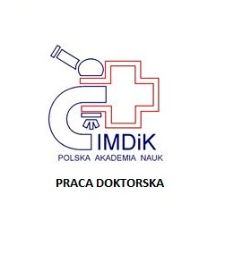- Search in all Repository
- Literature and maps
- Archeology
- Mills database
- Natural sciences
Advanced search
Advanced search
Advanced search
Advanced search
Advanced search

Object
Title: Udział transportera glutaminy SN1 w powstawaniu obrzęku mózgu i zaburzeń w neuroprzekaźnictwie glutamatergicznym : rola w zmianach obserwowanych w ostrej encefalopatii wątrobowej
Contributor:
Zielińska, Magdalena (Promotor)
Publisher:
Instytut Medycyny Doświadczalnej i Klinicznej im. M.Mossakowskiego PAN
Place of publishing:
Description:
Bibliogr. str. 124-150 ; 150 s.: il., wykr., fotogr.; 30 cm
Degree name:
Level of degree:
Degree discipline :
Degree grantor:
Instytut Medycyny Doświadczalnej i Klinicznej im. M. Mossakowskiego PAN
Type of object:
Abstract:
Hepatic encephalopathy (HE) is a neuropsychiatric disorder, which is usually caused by liver failure. As a result of hepatocellular dysfunctions, various neurotoxic compounds acumulate in the blood, from whih ammonia plays main role in the development of disease. Acute from of HE is characterized by rapid worsening of clinical symptoms, among which the most serious are: neurotransmission disorders , which in the late stages of the disease may manifest as convulsions or coma and brain edema, whoch may result in the patient's death. The neurotoxicity of ammonia is associated with changes in glutamatergic neurotransmission and with excessive production of glutamine (Gln) in astrocytes. Due to Gln osmotic properties its accumulation in the cells causes osmotic imbalance and the formation of cytotoxic component of cerebral edema. The accumulation of Gln in astrocytes may be caused by glutamine transport distrurbances. SN1 is the most important protein that regulates Gln transport out from astrocytes. The decrease of SN1 protein level was observed in the brain of rats with acutr HE induced by thioacetamide. The hypothesis assumr participation of the astrocytic SN1transporter in the retention of Gln in cells , which contributes to the occurrence of cytotoxic brain edema and glutamatergic neurotransmission disorders, twp clinically most seriosvsymptoms of acute HE. In the study we used two animal models, first was mice model of acute liver failure induced by azoxymethane (AOM) injection, and second was model using the vivo-morpholino technique based on local SN1 protein silencing. The mouse AOM model of acute HE reflects the characteristics of the symptomatic stage of acute HE in patients. Two main clinical manfestations, such as neurotransmission impairement (behavarioral and electrophysiological studies) and the occurence of both components of cerebral edema ( ultrastructure analysis, MRI technique, and 1H NMR) have been demonstrated. Reduction of the SN1protein expression and functional changes of the Gln transport suggest the role of the SN1 transporter in the observed clinical symptoms. Local silencing of the transporter by the vivo-morholino method resulted in the occurence of a cytotoxic component of brain edema (MRI, 1H NMR and extracellular measuremen of amino acids). In addition, the subtle changes in electrophysiological parametres documented the role of the SN! transporter in maintaning of glutamatergic transmission. The results of the study indicate the role of the Gln transport via the astrocytic Gln transporter SN1 in AOM-induced astrocytic and neural dysfunction.
Relation:
Format:
Resource Identifier:
Source:
IMDiK PAN, call no. ZS 386 ; click here to follow the link
Language:
Rights:
Creative Commons Attribution BY 4.0 license
Terms of use:
Copyright-protected material. [CC BY 4.0] May be used within the scope specified in Creative Commons Attribution BY 4.0 license, full text available at: ; -
Digitizing institution:
Mossakowski Medical Research Institute PAS
Original in:
Library of the Mossakowski Medical Research Institute PAS
Projects co-financed by:
Access:
Object collections:
- Digital Repository of Scientific Institutes > Partners' collections > Mossakowski Medical Research Institute PAS > Theses > Ph.D Dissertationes
- Digital Repository of Scientific Institutes > Literature > Thesis
Last modified:
Jan 5, 2023
In our library since:
Feb 6, 2019
Number of object content downloads / hits:
861
All available object's versions:
https://rcin.org.pl./publication/89420
Show description in RDF format:
Show description in RDFa format:
Show description in OAI-PMH format:
Objects Similar
Czynniki modulujące szlaki sygnałowe związane z cyklicznym GMP w mechnizmie encefalopatii wątrobowej
Zielińska, Magdalena
Kraśnicka, Zuzanna Albrecht, Jan Mossakowski, Mirosław Jan (1929–2001)
Matyja, Ewa Renkawek, Krystyna Śmiałek, Mieczysław Mossakowski, Mirosław Jan (1929–2001)
Wysmyk-Cybula, Urszula

 INSTYTUT ARCHEOLOGII I ETNOLOGII POLSKIEJ AKADEMII NAUK
INSTYTUT ARCHEOLOGII I ETNOLOGII POLSKIEJ AKADEMII NAUK
 INSTYTUT BADAŃ LITERACKICH POLSKIEJ AKADEMII NAUK
INSTYTUT BADAŃ LITERACKICH POLSKIEJ AKADEMII NAUK
 INSTYTUT BADAWCZY LEŚNICTWA
INSTYTUT BADAWCZY LEŚNICTWA
 INSTYTUT BIOLOGII DOŚWIADCZALNEJ IM. MARCELEGO NENCKIEGO POLSKIEJ AKADEMII NAUK
INSTYTUT BIOLOGII DOŚWIADCZALNEJ IM. MARCELEGO NENCKIEGO POLSKIEJ AKADEMII NAUK
 INSTYTUT BIOLOGII SSAKÓW POLSKIEJ AKADEMII NAUK
INSTYTUT BIOLOGII SSAKÓW POLSKIEJ AKADEMII NAUK
 INSTYTUT CHEMII FIZYCZNEJ PAN
INSTYTUT CHEMII FIZYCZNEJ PAN
 INSTYTUT CHEMII ORGANICZNEJ PAN
INSTYTUT CHEMII ORGANICZNEJ PAN
 INSTYTUT FILOZOFII I SOCJOLOGII PAN
INSTYTUT FILOZOFII I SOCJOLOGII PAN
 INSTYTUT GEOGRAFII I PRZESTRZENNEGO ZAGOSPODAROWANIA PAN
INSTYTUT GEOGRAFII I PRZESTRZENNEGO ZAGOSPODAROWANIA PAN
 INSTYTUT HISTORII im. TADEUSZA MANTEUFFLA POLSKIEJ AKADEMII NAUK
INSTYTUT HISTORII im. TADEUSZA MANTEUFFLA POLSKIEJ AKADEMII NAUK
 INSTYTUT JĘZYKA POLSKIEGO POLSKIEJ AKADEMII NAUK
INSTYTUT JĘZYKA POLSKIEGO POLSKIEJ AKADEMII NAUK
 INSTYTUT MATEMATYCZNY PAN
INSTYTUT MATEMATYCZNY PAN
 INSTYTUT MEDYCYNY DOŚWIADCZALNEJ I KLINICZNEJ IM.MIROSŁAWA MOSSAKOWSKIEGO POLSKIEJ AKADEMII NAUK
INSTYTUT MEDYCYNY DOŚWIADCZALNEJ I KLINICZNEJ IM.MIROSŁAWA MOSSAKOWSKIEGO POLSKIEJ AKADEMII NAUK
 INSTYTUT PODSTAWOWYCH PROBLEMÓW TECHNIKI PAN
INSTYTUT PODSTAWOWYCH PROBLEMÓW TECHNIKI PAN
 INSTYTUT SLAWISTYKI PAN
INSTYTUT SLAWISTYKI PAN
 SIEĆ BADAWCZA ŁUKASIEWICZ - INSTYTUT TECHNOLOGII MATERIAŁÓW ELEKTRONICZNYCH
SIEĆ BADAWCZA ŁUKASIEWICZ - INSTYTUT TECHNOLOGII MATERIAŁÓW ELEKTRONICZNYCH
 MUZEUM I INSTYTUT ZOOLOGII POLSKIEJ AKADEMII NAUK
MUZEUM I INSTYTUT ZOOLOGII POLSKIEJ AKADEMII NAUK
 INSTYTUT BADAŃ SYSTEMOWYCH PAN
INSTYTUT BADAŃ SYSTEMOWYCH PAN
 INSTYTUT BOTANIKI IM. WŁADYSŁAWA SZAFERA POLSKIEJ AKADEMII NAUK
INSTYTUT BOTANIKI IM. WŁADYSŁAWA SZAFERA POLSKIEJ AKADEMII NAUK


































